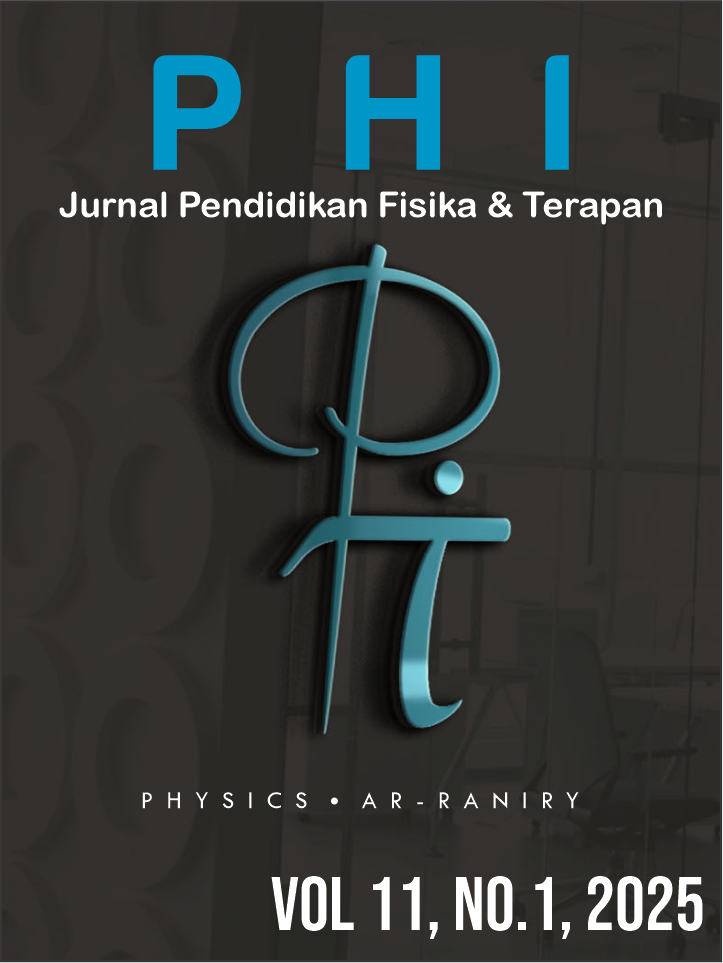The Influence of Visual Thinking Strategy In Augmented Reality (ViTSAR) to Improve Students' Visual Literacy Skills on Magnetic Field Material
DOI:
https://doi.org/10.22373/p-jpft.v11i1.28790Keywords:
ViTSAR, Visual Literacy Skills, Magnetic Fields, SMAN 1 Baros,Abstract
he purpose of this study was to examine the effect of ViTSAR inimproving students' Visual Literacy Skills on magnetic field material. Theresearch location was at SMAN 1 Baros in the 2024/2025 academic year. Theresearch method used was a quantitative research method. This type ofresearch is a quasi-experiment with a pretest-posttest nonequivalent controlgroup design. The population of the study was all grade XII MIPA studentsat SMAN 1 Baros. The sample of this study was 32 grade XII MIPA 1 studentsas the experimental class and 32 grade XII MIPA 2 students as the controlclass. The instruments used in this study were Visual Literacy Skills testquestions and student response questionnaires. The results of the t-testobtained a significance of 0.001, meaning that the t value was significant (p =0.001 <0.005), so there was an influence of the Visual Thinking Strategy inAugmented Reality (ViTSAR) learning media to improve Visual LiteracySkills on Magnetic Field material. The results of students' responses tolearning using ViTSAR media were very good, obtaining results of 80% sothat this method can improve students' Visual Literacy Skills, especially inlearning physics on magnetic field material.References
Afriyanto, E. (2015). Pengembangan Media Pembelajaran Alat Peraga pada Materi Hukum Biot Savart di SMA Negeri 1 Prambanan Klaten. Jurnal Riset Dan Kajian Pendidikan Fisika, 2(1), 20. https://doi.org/10.12928/jrkpf.v2i1.3131
Agustini, S., Arsyad, M., & Yani, A. (2018). Penggunaan Media Pembelajaran Virtual Lab Terhadap Pemahaman Konsep Fisika pada Peserta Didik SMA Negeri 1 Marioriwawo. Prosiding Seminar Nasional Fisika PPs Universitas Negeri Makassar, 1(April), 1–3. https://ojs.unm.ac.id/semnasfisika/article/view/8713
Alfitriani, N., Maula, W. A., & Hadiapurwa, A. (2021). Penggunaan Media Augmented Reality dalam Pembelajaran Mengenal Bentuk Rupa Bumi. Jurnal Penelitian Pendidikan, 38(1), 30–38. https://doi.org/10.15294/jpp.v38i1.30698
Balandin, S., Oliver, I., Boldyrev, S., Smirnov, A., Shilov, N., & Kashevnik, A. (2010). Multimedia services on top of M3 Smart Spaces. Proceedings - 2010 IEEE Region 8 International Conference on Computational Technologies in Electrical and Electronics Engineering, SIBIRCON-2010, 13(2), 728–732. https://doi.org/10.1109/SIBIRCON.2010.5555154
Elsayed, S. A., & Al-Najrani, H. I. (2021). Effectiveness of the Augmented Reality on Improving the Visual Thinking in Mathematics and Academic Motivation for Middle School Students. Eurasia Journal of Mathematics, Science and Technology Education, 17(8), 1–16. https://doi.org/10.29333/ejmste/11069
Lohr, L. (2008). Creating graphics for learning and performance : lessons in visual literacy. 1, 48–59.
Montalbano, V. (2014). Seeing and interacting with the invisible: A powerful tool for the learning of science. http://arxiv.org/abs/1401.3047
Nainggolan, E. R., Asymar, H. H., Nalendra, A. R. A., Anton, Sulaeman, F., Sidik, Radiyah, U., & Susafa’ati. (2018). The Implementation of Augmented Reality as Learning Media in Introducing Animals for Early Childhood Education. 2018 6th International Conference on Cyber and IT Service Management (CITSM), 1–6.
Nave, L. L. (2024). Pengembangan LKPD Digital Berbasis Expression untuk Menstimulus Kemampuan Literasi Visual pada Materi Medan Magnet. Digital Repostory Unila.
Nurmaulida, A., & Susanna, A. H. (2018). Pengaruh Kemampuan Matematika Terhadap Hasil Belajar Fisika di Man 3 Banda Aceh. Mahasiswa Pendidikan Fisika, 15–18. http://www.jim.unsyiah.ac.id/pendidikan-fisika/article/view/18612%0A http://www.jim.unsyiah.ac.id/pendidikan-fisika/article/download/18612/8525
Pateda, A. B., Kendek, Y., & Saehana, S. (2015). Analisis Pemahaman Konsep Magnet Mahasiswa Calon Guru Fisika. JPFT (Jurnal Pendidikan Fisika Tadulako Online), 3(2), 13. https://doi.org/10.22487/j25805924.2015.v3.i2.4471
Rizqillah, I. A., & Kholiq, A. (2023). Analisis Validitas Modul Berbasis Augmented Reality dan Literasi Sains (ARLISA) pada Materi Energi Terbarukan. Inovasi Pendidikan Fisika, 12(3), 35–40. https://ejournal.unesa.ac.id/index.php/inovasi-pendidikan-fisika/article/view/55586
Rizti Yovan, R. A., & Kholiq, A. (2021). Pengembangan Media Augmented Reality untuk Melatih Keterampilan Berpikir Abstrak Siswa SMA pada Materi Medan Magnet. PENDIPA Journal of Science Education, 6(1), 80–87. https://doi.org/10.33369/pendipa.6.1.80-87
Rose Amanda Puri, P., & Riki Perdana. (2023). Analisis Kemampuan Pemahaman Konsep Fisika Peserta Didik SMA di Bantul pada Materi Fluida Statis dan Upaya Peningkatannya Melalui Model Pembelajaran Visualization Auditory Kinesthetic. MAGNETON: Jurnal Inovasi Pembelajaran Fisika UNWIRA, 1(2), 93–101. https://doi.org/10.30822/magneton.v1i2.2463
Scaife, T. M., & Heckler, A. F. (2010). Student understanding of the direction of the magnetic force on a charged particle. American Journal of Physics, 78(8), 869–876. https://doi.org/10.1119/1.3386587
Setyaningsih, E. (2018). Identifikasi Miskonsepsi Materi Medan Magnet Menggunakan Three Tier Test pada Siswa Kelas XII SMA di Jember. FKIP E-Proceeding, 3(2015), 167–172.
Sidhartani, S. (2016). Literasi Visual sebagai Dasar Pemaknaan dalam Apresiasi dan Proses Kreasi Visual. Jurnal Desain, 3(3), 155–163.
Sugiyono. (2014). Metode penelitian bisnis: pendekatan kuantitatif, kualitatif, kombinasi, dan R&D. ALFABETA.
Sukserm, P., & Wasanasomsithi, P. (2023). From Pen to Pixels: Enhancing EFL Learners’ Writing Abilities Through the Use of Inquiry-Based Learning and Visual Literacy Model. REFLections, 30(3), 802–825. https://doi.org/10.61508/refl.v30i3.268439
Sutama, S. (2020). Kelayakan Media Buku Bergambar Berbasis Visual Thinking Strategies di Sekolah Dasar. Jurnal Varidika, 32(2), 1–12. https://doi.org/10.23917/varidika.v32i2.12855
Syarbini, N., Susilawati, E., & Mardhatillah, N. A. (2023). Jurnal PAJAR ( Pendidikan dan Pengajaran ) Volume 7 Nomor 4 Juli 2023 | ISSN Cetak : 2580 - 8435 | ISSN Online : 2614 - 1337 DOI : http://dx.doi.org/10.33578/pjr.v7i4.9494 A STUDY ON Visual Content Of Infographic Media Hierarchy As Kajian Isi Visual Hirar. 7(2019), 880–887.
Trisnawarni, E. C., & Yunianta, T. N. H. (2021). Proses Berpikir Visual Matematis Siswa Exstrovert dan Introvert Sekolah Menengah Atas Berdasarkan Tahapan Bulton. AKSIOMA: Jurnal Program Studi Pendidikan Matematika, 10(2), 820. https://doi.org/10.24127/ajpm.v10i2.3489
Tulende, S. D., Taunaumang, H., & Mondolang, A. H. (2021). Kemampuan Mengerjakan Soal Fisika Melalui Konsep Matematika Awal Proses Pembelajaran Fisika. Charm Sains: Jurnal Pendidikan Fisika, 2(1), 1–5. https://doi.org/10.53682/charmsains.v2i1.70
Downloads
Published
Issue
Section
License
Authors who publish with Jurnal Phi agree to the following terms:
- Authors retain copyright and grant the journal right of first publication with the work simultaneously licensed under a Creative Commons Attribution License (CC BY 4.0) that allows others to share the work with an acknowledgment of the work's authorship and initial publication in this journal.
- Authors are able to enter into separate, additional contractual arrangements for the non-exclusive distribution of the journal's published version of the work (e.g., post it to an institutional repository or publish it in a book), with an acknowledgment of its initial publication in this journal.
- Authors are permitted and encouraged to post their work online (e.g., in institutional repositories or on their website) prior to and during the submission process, as it can lead to productive exchanges, as well as earlier and greater citation of published work (See The Effect of Open Access).

















